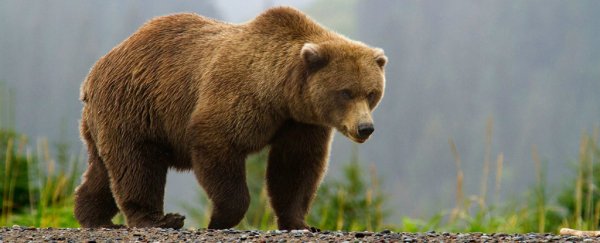During the peak of the last glacial period, some 25,000 years ago, the population of prehistoric cave bears (Ursus spelaeus complex) dwindled to a trickle. And then, there were none.
But while the once-flourishing species no longer roams the high alpines of Europe and Asia, a new study has found their DNA continues to live on, even today.
The findings reveal that about 0.9 to 2.4 percent of modern brown bear (Ursus arctos) DNA comes from the ancient cave bear.
Surprising even the authors, the study may well rewrite our understanding of extinction, which is typically considered absolute, and the old-fashioned idea of a species, which is traditionally defined through reproductive isolation.
"By any standard definition, [cave bears] are extinct, but it doesn't mean that their gene pool is erased, because they continue to live on in the genomes of these living animals," one of the researchers, evolutionary biologist Axel Barlow from the University of Potsdam, told National Geographic.
The research is only the second of its kind to show that when a species goes extinct, fragments of its gene pool can survive for tens of thousands of years after its disappearance.
The first example being the presence of Neanderthal DNA in modern day humans, which is thought to make up between 1.5 and 4 percent of the non-African human genome.
"[W]e have shown that a fraction of the cave bear gene pool survives in the genomes of living brown bears, mirroring the Neanderthal ancestry found in non-African humans, but at a much deeper phylogenetic divergence," the authors write in the paper.
"This result forces a reevaluation of the very concept of species extinction".
Barlow and his colleagues were initially focused on extracting DNA from the petrous bones of four Late Pleistocene cave bears, which they used to sequence the ancient species' genome.
But then, on a whim, the team decided to compare their findings to other species as well.
Gathering together the genomic sequences from one ancient and four modern brown bears, as well as black bears, spectacled bears, pandas, and polar bears, the researchers found something unexpected.
Today, it's known that sometimes polar bears and brown bears interbreed. Yet the researchers discovered that the brown bear shared more individual genome positions with the ancient cave bear than with the modern polar bear – which indicates that brown bears and cave bears interbred and were hybridised before cave bears went extinct.
Not only do brown bears appear to carry the DNA of their ancient ancestors, the cave bears themselves were found to house brown bear DNA, albeit in smaller proportions. The explanation was clear.
"There was a really quite obvious signal of hybridisation between these species," Barlow told The New York Times.
"We did not expect to find this at all because they're really quite diverse in terms of their evolution," he added.
In some ways, however, the discovery makes sense. While the cave bear was mainly a herbivore and 20 percent larger than a brown bear, they still look very similar, and they did roam roughly the same territories at roughly the same time.
From the free flow of genes between these two species, the authors conclude that brown bears and cave bears may have interbred and been hybridised before extinction claimed the latter.
Unable to withstand the glacial period's bitter cold temperatures and the rise of hunting and human competition, the cave bear went the same way as many other large mammals at the end of the Pleistocene.
Yet for some reason, the ancient ancestor of the brown bear made it through, and Barlow thinks that could have something to do with the advantage bestowed by interbreeding.
The theory is not too far-fetched. Previous studies, for example, have shown that in humans, genes from early hominin species may have helped the Tibetans adapt to high altitudes.
"Brown bears are a widespread and successful species that has been recipient of alleles from two ecologically and morphologically divergent lineages in their recent evolutionary history: cave bears and polar bears," the authors write.
Because of their genomic heritage, brown bears offer an excellent opportunity to study the advantages, or even disadvantages, that interbreeding may confer on a species and its survival.
Future research could help conservationists figure out how to preserve today's endangered species.
The study has been published in Nature Ecology & Evolution.
